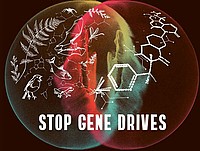Regulation of Gene Drive Organisms at EU Level
The political debate surrounding the regulation of gene drive technology at the European level is still in its infancy.
In July 2018, the European Commission commissioned the European Group on Ethics in Science and new Technologies (EGE) to develop an opinion and policy recommendations around the ethical, social and legal implications of new genetic engineering techniques (genome editing) on humans, animals and plants. It is expected in spring 2021. In this context, a roundtable was held in Brussels in October 2019, where participants from science, industry, politics and civil society discussed the ethical issues around new genetic engineering applications, including gene drives. As concrete environmental applications for the use of gene drives in the EU are still a thing of the future, the political debate has so far focused on the EU's positioning in the negotiations of the UN Convention on Biological Diversity (CBD).
Prior to the 14th Conference of the Parties (COP) to the CBD in Egypt, the EU Council of Ministers recognized for the first time "potential adverse effects on biodiversity" from gene drive organisms and considered it necessary to apply the Convention's precautionary approach.
In January 2020, the European Parliament adopted a resolution calling on the European Commission and the EU Council of Ministers to advocate for a global gene drive moratorium at the upcoming Conference of the Parties to the UN Convention on Biological Diversity (COP 15) in China. In addition, MEPs called for the new Post-2020 Global Biodiversity Framework to be based on the following core principles: the precautionary principle, a rights-based approach to involve rights holders in the development of legislation affecting them, and mandatory prior technology assessment of new technologies that could have a negative impact on biodiversity. In doing so, MEPs responded to a joint call from 50 European NGOs, experts and foundations.
Here we present the current state of debate and decision-making by European institutions:
In the EU, Directive 2001/18 regulates the conditions under which genetically modified organisms (GMOs) may be released into the environment. It is undisputed that gene drive organisms are forms of GMO.
The transposition of the requirements of the EU Directive into national law is mandatory for all member states. Only the EU institutions can make changes to the directive. Since 2015, however, member states have been able to prohibit the cultivation of genetically modified plants on their territory even if approval has been granted for them at EU level (opt-out). In theory, this also applies to gene drive organisms.
Directive 2001/18 requires member states to take all necessary measures to avoid adverse effects from releases of GMO on the environment and human health . It is not possible to weigh conceivable advantages for human health up against possible disadvantages for the environment., Both protection goals are of equal importance. The reference to the precautionary principle obliges the competent authorities to take measures to prevent a negative effect even if full scientific or technical certainty and knowledge has not yet been obtained.
Legal interpretation of the EU directive 2001/18 with regard to gene drive organisms
According to the EU's Genetic Engineering Directive 2001/18, any release of a GMO requires approval, which may only be granted if it has been established, on the basis of a prior risk assessment involving the member states and the European Commission, that the release will not have any harmful effects on human health or the environment. The protection of the environment and human health must be ensured in accordance with the precautionary principle. The period of validity of the authorization must not exceed ten years. The released GMO and its potential effects must be monitored throughout the period according to a monitoring plan to be submitted. The aim of the directive 2001/18 is to prevent the uncontrolled spread of GMOs into the environment and their outcrossing to other organisms. Even the spread of a GMO in the environment beyond the planned site of release is assessed as a negative effect in this context. If there is a risk to the environment or human health, approval for a release may not be granted.
Recital 4 of the directive underlines the specific problem of deliberate release of GMOs into the environment: "Living organisms released into the environment in large or small quantities for experimental purposes or in the form of commercial products may reproduce in the environment and spread beyond national borders, thereby affecting other member states. The effects of such releases may be irreversible.“
To identify and assess risks to the environment and human health, a risk assessment must identify any new risks prior to any release of a GMO into the environment. Annex II of the Directive sets out the requirements for this risk assessment. It requires that all intended and unintended, direct and indirect, immediate and delayed, long-term and cumulative long-term effects of the release be examined. Cumulative long-term effects include, among others, effects of the released GMOs on food chains, flora and fauna, and biodiversity. The effects on altered population dynamics and genetic diversity of target species, as well as their competitors, prey, hosts, symbionts, predators, parasites and pathogens must also be covered by the risk assessment.
Furthermore, it is specified that possible negative effects are not to be excluded from the assessment of risks because they are unlikely to occur. Furthermore, it is stated that there is no distinction between significant and other (negligible) negative effects. The guideline thus prescribes a worst-case scenario as the basis of the risk assessment and requires that it be assumed that every potential negative effect will also occur.
For safety reasons, the directive recommends that the release of a GMO should be carried out step by step and that each subsequent step should only be taken if the assessment of the previous steps did not indicate any adverse effects on human health or the environment. However, a step by step procedure will not be possible due to the nature of gene drive organisms: Sufficiently reliable proof of the harmlessness of a GDO can only be provided if the GDO has been released into the environment and there has been no evidence of hazards to the environment or human health over several generations. However, the release of even just a few genes drive organisms results in their possibly irreversible spread in the environment. According to the current state of research, once GDOs have been released, their spread cannot be limited or be recovered with certainty, and their effects in nature cannot be reversed.
In order to take into account the particular risk posed by a self-replicating spread into the environment, the approval of a GMO can be granted for a maximum of 10 years. After that, it must either be renewed or it expires. Once the approval has expired, the GMO may not be found in the environment any longer. It is not apparent how this provision would be complied with in relation to GDO. Directive 2001/18 was designed and enacted to regulate the release of genetically modified crops. It assumes that the effect and spread of GMO in nature can be limited in space and time. However, according to the current state of research, this assumption does not hold for gene drive organisms.
Conclusion: The release of gene drive organisms is unlikely to be permissible under current EU law.
Decision of the European Parliament
In January 2020, the European Parliament adopted a resolution calling on the European Commission and the EU Council of Ministers to support a global gene drive moratorium at the forthcoming Conference of the Parties to the UN Convention on Biological Diversity (COP 15) in China in October 2020. In addition, MEPs called for the new post-2020 global biodiversity framework to be based on a number of key principles, including the precautionary principle, a rights-based approach to involving stakeholders in the development of legislation affecting them and mandatory prior technology assessment of new technologies that could have a negative impact on biodiversity. The MEPs followed a joint call from 50 European NGOs, experts and foundations.
Positioning of the EU Council of Ministers
Prior to the 14th Conference of the Parties (COP) of the CBD in Egypt, the EU Council of Ministers recognised potential adverse impacts of gene drive organisms on biodiversity for the first time and considered it necessary to apply the precautionary approach of the Convention.
Activities of the European Commission
In July 2018, the European Commission commissioned the expert group ‚European Group on Ethics in Science and New Technologies‘ (EGE) to draw up an opinion and political recommendations on the ethical, social and legal effects of new genetic engineering methods (genome editing) on humans, animals and plants. It is expected in spring 2021. In this context, a round table was held in Brussels in October 2019, at which participants from science, industry, politics and civil society discussed the ethical issues surrounding new applications of genetic engineering, including gene drives.
Risk assessment by the European Food Safety Authority
The risk assessment, which is carried out as part of the approval review of a GMO, is carried out by the European Food Safety Authority (EFSA). It develops specific guidelines for its implementation.
Both the guidelines for environmental risk assessment and the guidelines for risk assessment of genetically modified animals are relevant for gene drive organisms. Should plants also be modified by gene drives in the future, the guidelines for the risk assessment of food and feed from genetically modified plants would also be relevant. For genetically modified plants only, there are also post-market environmental monitoring (PMEM) guidelines that govern the management and monitoring strategies for released genetically modified plants.
At the time this publication went to press, no genetically modified animals or products derived from them, had been approved for marketing in the EU. There were also no applications for this. Nevertheless, guidelines for the risk assessment of genetically modified animals exist as an aid for future applications.
These guidelines for the risk assessment of genetically modified animals published by EFSA in 2013 already contained considerations on horizontal gene transfer through gene drive systems in the section on insects, among other things. Since 2013, several scientific bodies had been looking at the risk assessment of synthetic biology applications and had seen a need for action with regard to gene drives. The scientific committee of the French High Council for Biotechnology (Haut Conseil des Biotechnologies, HCB) concluded in a May 2017 opinion that the risk assessment criteria of Directive 2001/18/EC were applicable to gene drive organisms. However, it noted that GDOs introduce new elements and objectives that require adaptation of the existing risk assessment.
In June 2018, the European Commission mandated EFSA to consider whether existing guidance on the risk assessment of GM animals was sufficient to identify potential new risks to the environment, human and animal health, or whether it needed to be adapted. However, this did not include a mandate to develop new guidelines for risk assessment of GDO. However, the technical and scientific expertise on GDO risk assessment developed through this mandate is intended to inform the consideration of guidelines for the risk assessment of gene drive organisms under the Convention on Biological Diversity and its Cartagena Protocol on Biosafety.
In May 2019, EFSA organized a public hearing on the status of its deliberations. The final report was presented in November 2020. However, the composition of the scientific working group, which was commissioned to draft the report, has been criticized for being biased. According to research by the Brussels-based non-governmental organization Corporate European Observatory (CEO), all six members of the working group have conflicts of interest related to the development of GDO, as they work in companies or research groups whose activities fall under EFSA's remit. Three of the experts have financial ties to organizations developing gene drives, including Target Malaria and the U.S. military agency DARPA.



